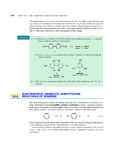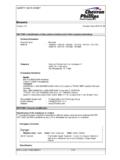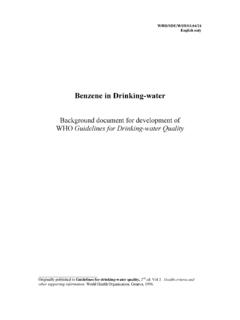Transcription of EXPOSURE TO BENZENE: A MAJOR PUBLIC HEALTH …
1 PREVENTING DISEASE THROUGH HEALTHY ENVIRONMENTS EXPOSURE TO benzene : A MAJOR PUBLIC HEALTH CONCERN Human EXPOSURE to benzene has been associated with a range of acute and long-term adverse HEALTH effects and diseases, including cancer and aplastic anaemia. EXPOSURE can occur occupationally and domestically as a result of the ubiquitous use of benzene -containing petroleum products, including motor fuels and solvents. Active and passive EXPOSURE to tobacco smoke is also a significant source of EXPOSURE . benzene is highly volatile, and EXPOSURE occurs mostly through 3 PUBLIC HEALTH actions are needed to reduce the EXPOSURE of both workers and the general population to benzene . Sources of EXPOSURE to benzene benzene is highly volatile, and most EXPOSURE is through inhalation.
2 benzene is degraded rapidly in the upper atmosphere. Because of its solubility in water, a minor amount may be removed by rain to contaminate surface waters and soil. However, it is not persistent in surface water or soil, either volatilizing back to air or being degraded by bacteria. Industrial processes As benzene occurs naturally in crude petroleum at levels up to 4 g/l, human activities using petroleum lead to EXPOSURE . These activities include processing of petroleum products, coking of coal, production of toluene, xylene and other aromatic compounds, and use in industrial and consumer products, as a chemical intermediate and as a component of petrol (gasoline) and heating oils.
3 The presence of benzene in petrol and as a widely used industrial solvent can result in significant occupational EXPOSURE and widespread emissions to the environment. Automobile exhaust accounts for the largest source of benzene in the general environment. Off-gassing from building materials and structural fires lead to increased atmospheric benzene levels. Industrial discharge, landfill leachate and disposal of benzene -containing waste are also sources of Indoor residential air benzene has been detected at high levels in indoor air. Although some of this EXPOSURE might be from building materials (paints, adhesives, etc.), most is from cigarette smoke in both homes and PUBLIC spaces. Levels of benzene are higher in homes with attached garages than in those with detached garages.
4 Levels are increased in homes close to petrol filling benzene may be released to indoor air from unflued oil heating and from the use of benzene -containing consumer products in residences. People spending more time indoors, such as children, are likely to have higher EXPOSURE to benzene . Inside vehicles benzene has been measured in air inside vehicles at levels higher than those in residential air, but substantially lower than those at petrol filling Food and water Waterborne and foodborne benzene contributes only a small percentage of the total daily intake in non-smoking World HEALTH Organization (WHO) benzene guidelines Drinking-water mg/l (guideline values corresponding to the upper 95% confidence limit of modelled excess lifetime cancer risks of 10 4, 10 5 and 10 6 are , and mg/l, respectively).
5 5,6 An excess lifetime cancer risk of 10 4, 10 5 or 10 6 means the risk of one new cancer case above background levels per 10 000, 100 000 or 1 million people, respectively. Air No specific guideline value has been developed for air. benzene is carcinogenic to humans, and no safe level of EXPOSURE can be recommended. For general guidance, the concentrations of airborne benzene associated with an excess lifetime risk of leukaemia of 10 4, 10 5 and 10 6 are 17, and g/m3, HEALTH effects Acute effects Acute occupational EXPOSURE to benzene may cause narcosis: headache, dizziness, drowsiness, confusion, tremors and loss of Use of alcohol enhances the toxic benzene is a moderate eye irritant and a skin Effects following chronic EXPOSURE benzene is a well-established cause of cancer in ,3 The International Agency for Research on Cancer has classified benzene as carcinogenic to humans (Group 1).
6 1,3 benzene causes acute myeloid leukaemia (acute non-lymphocytic leukaemia), and there is limited evidence that benzene may also cause acute and chronic lymphocytic leukaemia, non-Hodgkin's lymphoma and multiple myeloma. Individuals who have experienced benzene poisoning requiring treatment show a substantially increased risk of mortality from Chronic EXPOSURE to benzene can reduce the production of both red and white blood cells from bone marrow in humans, resulting in aplastic Both B-cell proliferation and T-cell proliferation are reduced by benzene . Decreased host resistance to infection has been reported in several laboratory animals exposed to benzene . However, other measures of immunotoxicity have not been Chromosomal aberrations in human peripheral lymphocytes are associated with occupational EXPOSURE to benzene .
7 Chromosomal aberrations, micronuclei, sister chromatid exchange and sperm head abnormalities have been seen in laboratory species treated in vivo. Chromosomal aberrations and mutations were seen in human cells in vitro and in laboratory animal cells in some in vitro ,2 benzene is fetotoxic in mice and rabbits following maternal EXPOSURE by inhalation, causing a reduction in birth It is not, however, teratogenic in experimental animals, even at maternally toxic doses. Monitoring EXPOSURE Estimates of benzene EXPOSURE can be made through measurement of urinary inorganic and organic sulfate conjugates. Measurement of urinary phenol levels has historically been the standard bioassay for benzene EXPOSURE , despite the well-described limitations of this The haematological effects of chronic benzene poisoning in exposed workers can be detected by monitoring blood counts at regular intervals.
8 For example, the United States Occupational Safety and HEALTH Administration recommends monthly blood counts and removal of workers from areas with high benzene EXPOSURE if they have white blood cell counts below 4000/mm3 or erythrocyte counts below 4 000 000 Risk mitigation recommendations Eliminate use Promote the use of alternative solvents in industrial processes, glues and paints. Develop and implement policies and legislation to remove benzene from consumer products. Reduce EXPOSURE Reduce EXPOSURE at petrol filling stations as far as possible by following best practices in location, design and extraction. Minimize emissions from vehicle exhausts by improved design and regular monitoring of engine settings.
9 Separate dwelling spaces from areas where vehicles and benzene -containing products are kept. In particular, isolate children from indoor EXPOSURE to vehicle emissions. Avoid domestic use of benzene -containing products. Discourage indoor use of unflued oil and gasoline heating. Prohibit smoking inside buildings. Education Raise PUBLIC awareness regarding sources of EXPOSURE to benzene and risk mitigation measures. Conduct educational activities to discourage the use of benzene or petrol for cleaning and degreasing in industry and domestically. References 1. IARC (1987). Summaries & evaluations: benzene (Group 1). Lyon, International Agency for Research on Cancer, p. 120 (IARC Monographs on the Carcinogenicity of Chemicals to Humans, Supplement 7; ).
10 2. IPCS (1993). benzene . Geneva, World HEALTH Organization, International Programme on Chemical Safety (Environmental HEALTH Criteria 150; ). 3. IARC (in preparation). A review of human carcinogens. F. Chemical agents and related occupations. Lyon, International Agency for Research on Cancer (IARC Monographs on the Evaluation of Carcinogenic Risks to Humans, Vol. 100) [summary in Baan R et al. (2009). A review of human carcinogens Part F: Chemical agents and related occupations. The Lancet Oncology, 10(12):1143 1144; (09)70358-4/fulltext]. 4. WHO (2000). benzene . In: Air quality guidelines for Europe, 2nd ed. Copenhagen, World HEALTH Organization Regional Office for Europe ( ). 5. WHO (2003). benzene in drinking-water.
















